Stake Tomato plants to support your Tomato and assist its upward growth habit. Tomatoes must be supported as they grow, so they are clean, less susceptible to disease, and able to ripen fully. There are many ways you can stake your Tomato plants to keep them out of the ground and support them. It also helps to promote strong, sturdy plants that produce abundant fruit.
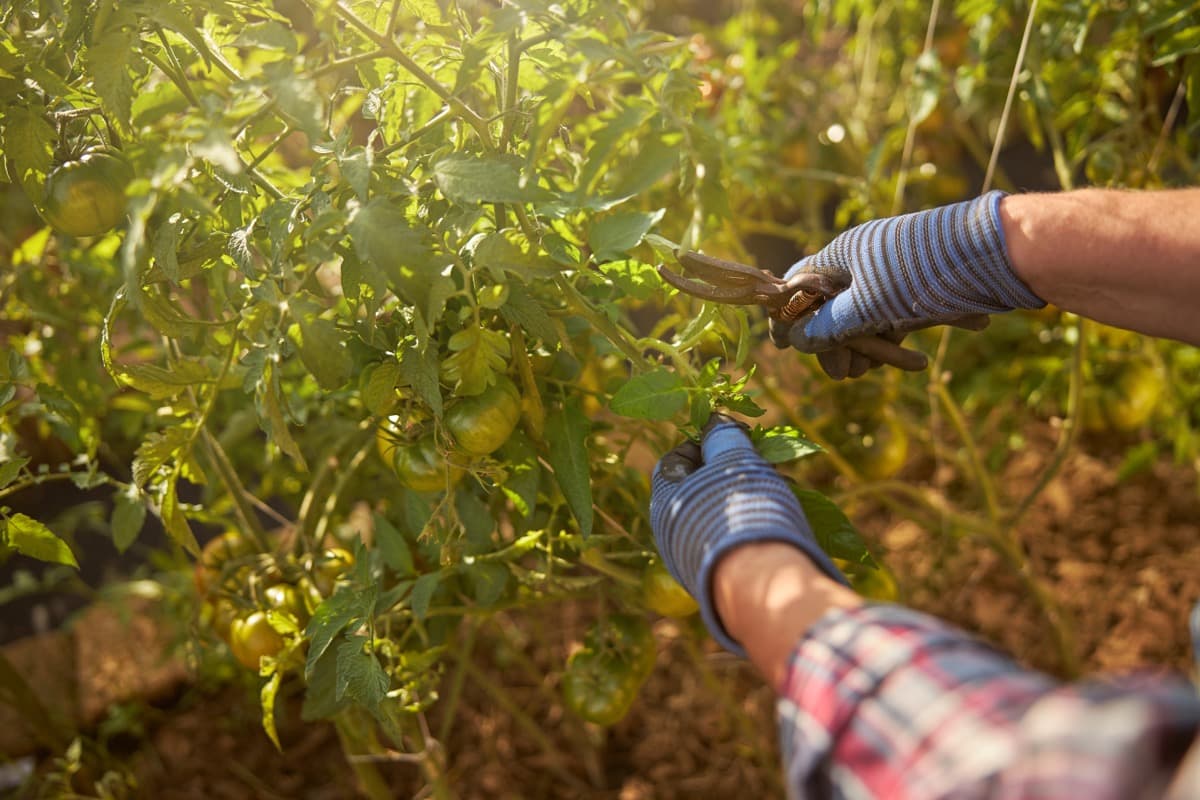
How to stake your Tomato plants
What does it mean to stake a Tomato plant?
Staking Tomatoes helps keep the plants off the ground while helping their upward growth habit. However, because many diseases and pests are soil-borne, a systematic approach is prudent to keep them out of ground contact.
How to stake Tomato plants in pots?
Firstly, make sure the pot has adequate drainage. If the soil is too wet, it won’t be easy to secure the stakes properly. Next, line the bottom of the pot with several inches of fresh, organic gardening soil. Next, cut several short pieces of sturdy wire or nylon rope and insert them into the soil at equal distances from each other around the circumference of the pot. Take care not to pull on the stakes as you do this; they should be touching one another. Finally, place your Tomato plant into the center of the pot, ensuring its roots are well-covered by soil.
Why should you stake Tomatoes?
- Staking your Tomatoes keeps them organized and saves a lot of space in your garden.
- When you stake your Tomatoes, you reduce the risk of them rotting or spreading diseases.
- The stakes also make them less accessible to garden pests and insects.
- Staking makes access to all parts of the plant easy for trimming and harvesting.
In case you missed it: State Wise Tomato Farming Seasons in India: Growing Best Varieties and Production Yield

Methods to stake Tomato plants
Single-stake
This method, one of the most straightforward and practical staking systems, involves planting a stake into the soil or mulching a few inches beside a Tomato plant. Once the plant has reached almost a foot in height, use some garden twine to tie the plant to the stake. Stake it every half foot or so. It works best with determinate Tomatoes, which only grow to a certain height and produce most fruit early.
Using a single stake is the simplest and most economical form of supporting Tomato. Depending on the soil type, stakes should be driven 6 to 12 inches deep into the ground, providing firm support. The stake can be made of wood, plastic, or metal. Metal stakes, such as fence-type tee posts, are probably the most durable and can last many seasons. Begin staking your Tomato plant after it reaches a height of 10 to 12 inches.
Garden twine, fabric strips, or even pantyhose are great materials to use as ties for your stakes. Next, stake your Tomato plant about every 8 inches or so along the entire length of the main stem. Although the single-staking system is simple and inexpensive, it provides the least support of all the options. Also, it works best on stockier, defined varieties. Indeterminate varieties and vigorous cherry Tomatoes need more support structure as they grow.
Florida Weave
The Florida weave method gives plants the support they need using only stakes. Start by planting your Tomato transplants in a row, leaving adequate space between each plant. Plant stakes at either end of the row and between every third or fourth Tomato plant, ensuring each stake is securely in the soil.
Stakes can be made from any material you choose, but metal tee posts are more efficient and safer than wooden ones. Once all the stakes are secured, tie a durable wire around one of the ends 1 or 2 inches from the ground. Next, begin weaving the string in and out between each Tomato plant, keeping the string tight and looping the string once around each center post to create extra support.
In case you missed it: Tomato Farming Business Plan: A Production and Cultivation Guide for Beginners
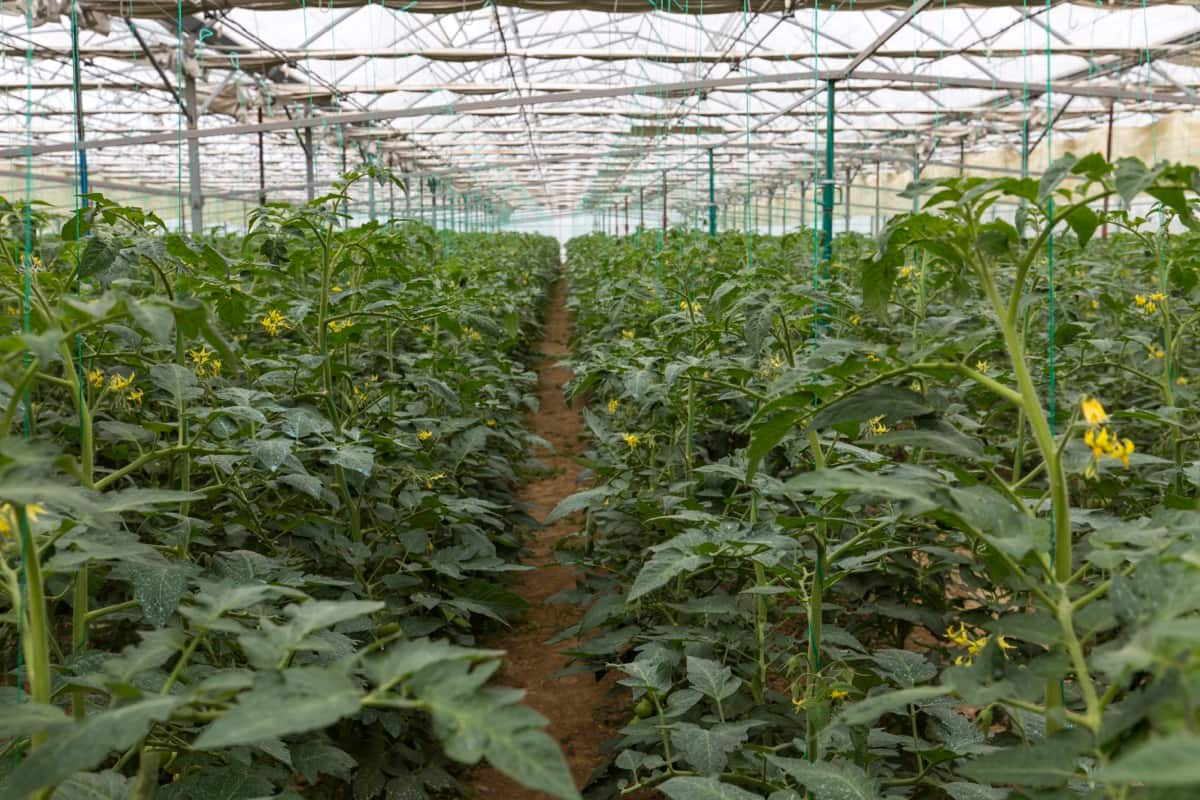
At the end of the row, cut the string and tie it to the stake. Repeat the process, making sure the wire is on the opposite side of the plant, as before. Leave about 1 or 2 inches between each set of woven string until the string is at the top of each plant. This allows you to place the Tomato plant between the extra woven wire once it has grown.
String method
The string method allows you to create a string trellis in your vegetable garden. Plant your Tomatoes in a row a couple of feet from each other. Place a support beam parallel to the ground about ten feet above the plants. Toss a long line of jute over the beam—one line per plant.
There should be enough string to carry up to one side of the beam and down the other, plus some extra on the floor. Take the two ends of the twine and tie a loose knot around the plant base, and as your plant ascends, wind other tiny knots along your growing Tomato to help encourage its upward growth. This works well with indeterminate Tomatoes, which grow higher than determinate varieties.
Double-stake
The double-stake method can be helpful for heirloom Tomatoes and other larger Tomatoes needing more support. Growers should place two stakes on opposite sides of the plant base. Tie some twine around the main stem and the stakes. If you are planting multiple Tomatoes in a row, allow for a couple of feet between each plant for air circulation and even watering.
In case you missed it: High Yield Tomato Varieties in India: A Farmer Guide for Good Profits
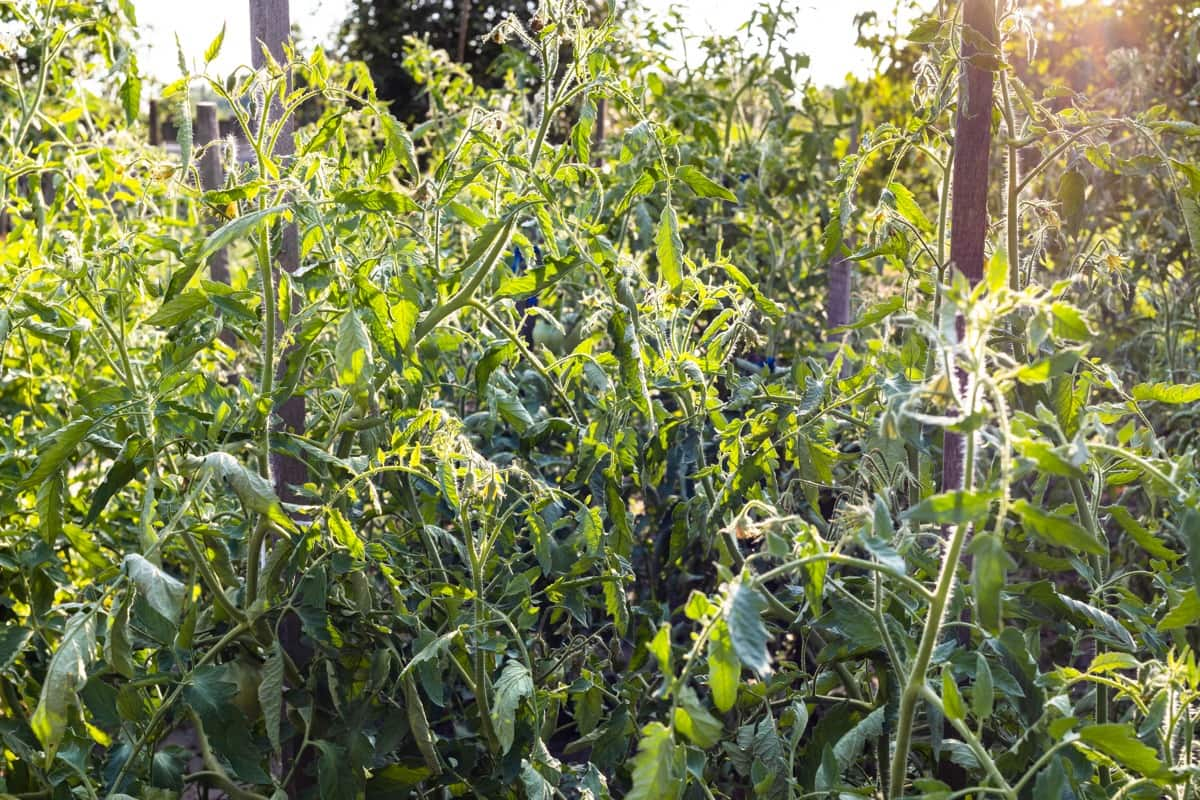
Benefits of staking Tomato plants
- With more space to grow, Tomato plants can produce more fruit. In addition, staking spreads out the vine, offering more sunlight to different plant parts to encourage more and larger fruits.
- Plants on the ground can rot more quickly due to flooding, trampling, and more. Pests can also more easily access the fruits, so growing them on stakes means they will avoid pesky garden creatures.
- A stake can also be used as a support for climbing Tomatoes. If you have a garden with high walls or fences, stakes can help support the plants as they grow upwards. This is helpful if you have a spot that is difficult or impossible to reach for pruning or harvesting.
- Staking helps to stabilize the Tomato plant, making it less likely to tip over in high winds or during heavy rainfalls.
- It’s a great way to encourage even growth and produce larger, more bountiful Tomatoes.
- By stakes, you also help hold down weeds and other growing organisms that could compete with your Tomato plants for water and nutrients.
- Staking Tomato plants helps support the plants and can increase yields. Staked plants are sturdy and will not droop or fall over. The stakes can also help to keep the plants at a consistent height, which is important for uniform fruit production.
How high should Tomato stakes be?
Stakes should extend at least four feet above the soil surface – preferably 7-8 feet as the plants can grow tall. Wait to stake the plants until after the first flowering. This encourages the main stem to become stronger. Then, tie the branches to stakes for support.
In case you missed it: Top 24 Steps to Boost Tomato Yield: How to Increase Production, Quality, and Size
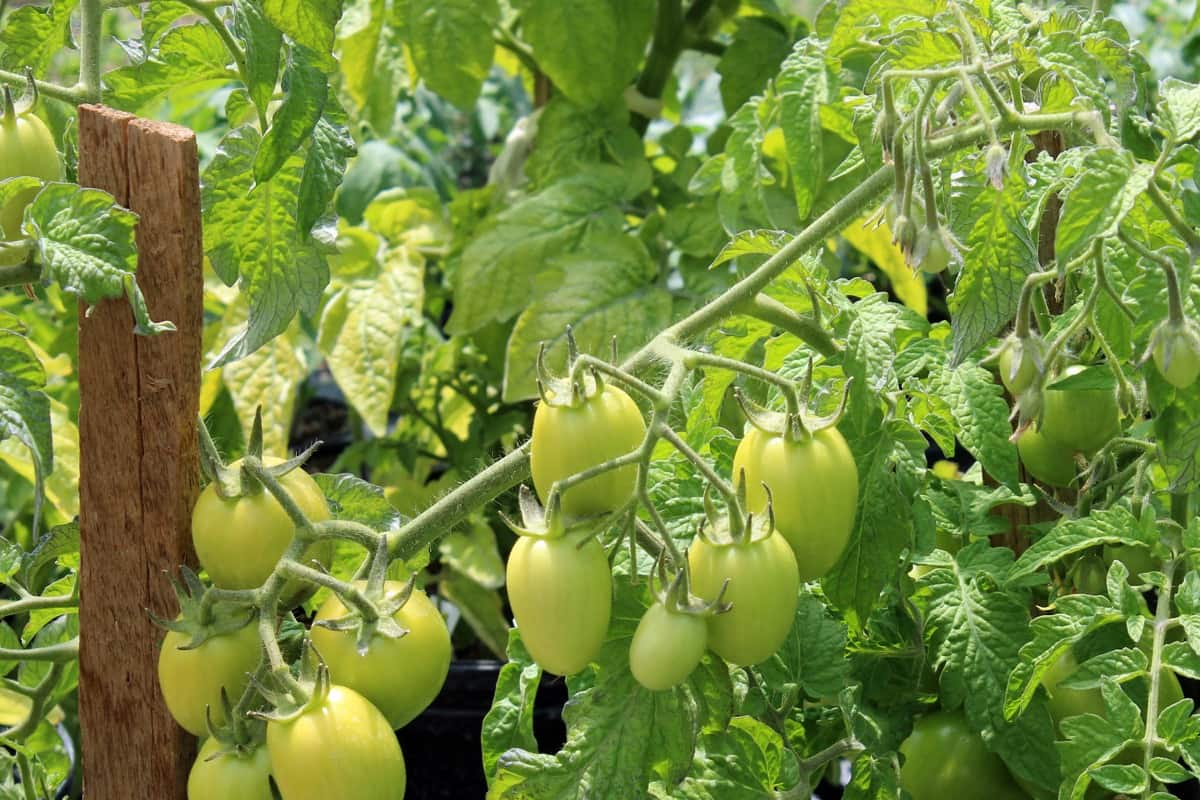
Stake Tomatoes with fencing panels
- A fencing panel provides additional support for Tomato plants.
- Install the panels before planting the Tomatoes.
- Drive stakes or T-posts about 4-6 feet into the ground.
- Place the welded wire grid or fencing panel flat against the stake. Use zip ties or wire to attach the wire panels to the T-posts.
- Plant the Tomatoes at the base of the panel.
- Weave Tomato stems in and out of the panel grid as they grow throughout the season. Tie the stem to a panel grid for extra support.
- Agricultural panels work best when growing a row of Tomato plants rather than just a few.
Different ways to stake your Tomato plants
There are several ways to stake your Tomato plants: using wire, tying with string, using bamboo poles, or using stakes made of plastic or metal.
- To use wire stakes, bend one end into a loop and insert the other into the ground next to the plant. Make sure that the stake is deep enough so that it will not touch the soil. Tie the loop in place with a piece of string. Repeat on each side of the plant.
- To tie with string, take several lengths and make a loop at one end. Place this loop over the stem near where you want it to attach and tie it securely. Ensure the knot is high up on the stem so it will not touch the soil. Do this on both sides of the plant.
- To use bamboo poles, cut two short pieces of bamboo about 2 feet long and insert them into the ground next to each other about 8 inches from the top of your Tomato plants. Dig a hole for each pole just large enough for it to fit comfortably into with plenty of space left around it. Push down firmly on each end of each pole until they are sitting upright in their holes. Tie one end of a string around each pole and pull tight to secure. Repeat on the opposite side of the plant.
- Plastic stakes come in various sizes and can be easily found at most garden stores. They are easy to use and need to be inserted into the ground at a height that will allow the Tomato Plant to stand straight but not touch each other.
- Metal stakes are also available in various sizes and shapes, but they can be more challenging to use. First, they need to be hammered into the ground to form a U-shape, and then the Tomato Plant can be attached by tying it around the middle of the U-shape.
In case you missed it: Mulching Tomato Plants, Procedure, and Benefits
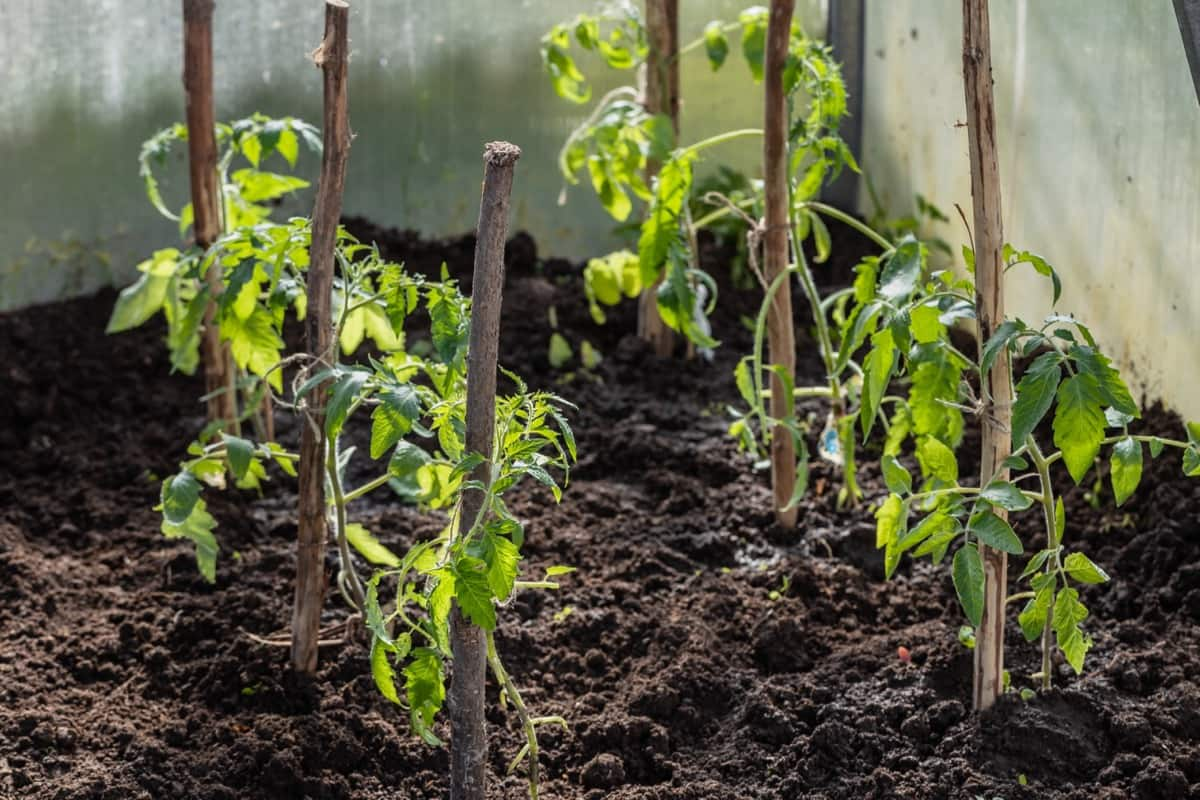
When to stake Tomato plants?
The best time to stake your Tomato plants is before they are transplanted (or seeded if direct sown).
How to stake determinate Tomatoes?
Install Cage or Drive Stakes – You can purchase a small or medium-sized Tomato cage for a specific Tomato plant. Place the support around it while it’s still small so you don’t damage the plant. A Tomato plant will fill out its support as it grows, and you’ll only need to tie it in a few places. Alternatively, you can use wooden stakes for your determinate Tomatoes. The advantage of staking is that it is less expensive.
Another benefit of fixed Tomatoes for the low-maintenance fan is that you don’t have to bother cutting out the suckers because they stay compact. Wooden stakes should be 2 inches square and 4 to 7 feet long, depending on the cultivar you are raising. If necessary, trim the bottom of the stake to a pointed tip. Then, put it about 15 inches into the ground.
Secure the plant stems – Use fabric strips (or vinyl plant stretch ties) to secure the Tomato plant loose stems to the cage or stake.
How to Stake Indeterminate Tomatoes?
Build stakes – An indeterminate Tomato stake should be 7 feet tall and 2 inches x 2 inches wide. It must be strong, as a vine loaded with Tomatoes can be quite heavy. One end of the stake must be pointed, so it is easy to drive into the ground; if you buy without a point, cut wood on one end to make a point.
Drive stakes – Use a small sledgehammer to drive stakes into the ground about 24 inches. Place the stake about 5 inches from the Tomato plant so you don’t damage the roots. Or, plant all the stakes and then plant the Tomatoes.
Secure the stems – Use soft cloth strips to secure the plant stems to the stake. Alternatively, you can use long vinyl plant ties to secure the stems.
Prune Away Suckers – Cut off suckers that can sap the plant’s vigor. These shoots grow in the spaces between the main stem and the fruiting branches. This pruning also improves air circulation and makes the plant less susceptible to disease.
In case you missed it: Hydroponic Tomato Farming, Nutrient Solution, Yield
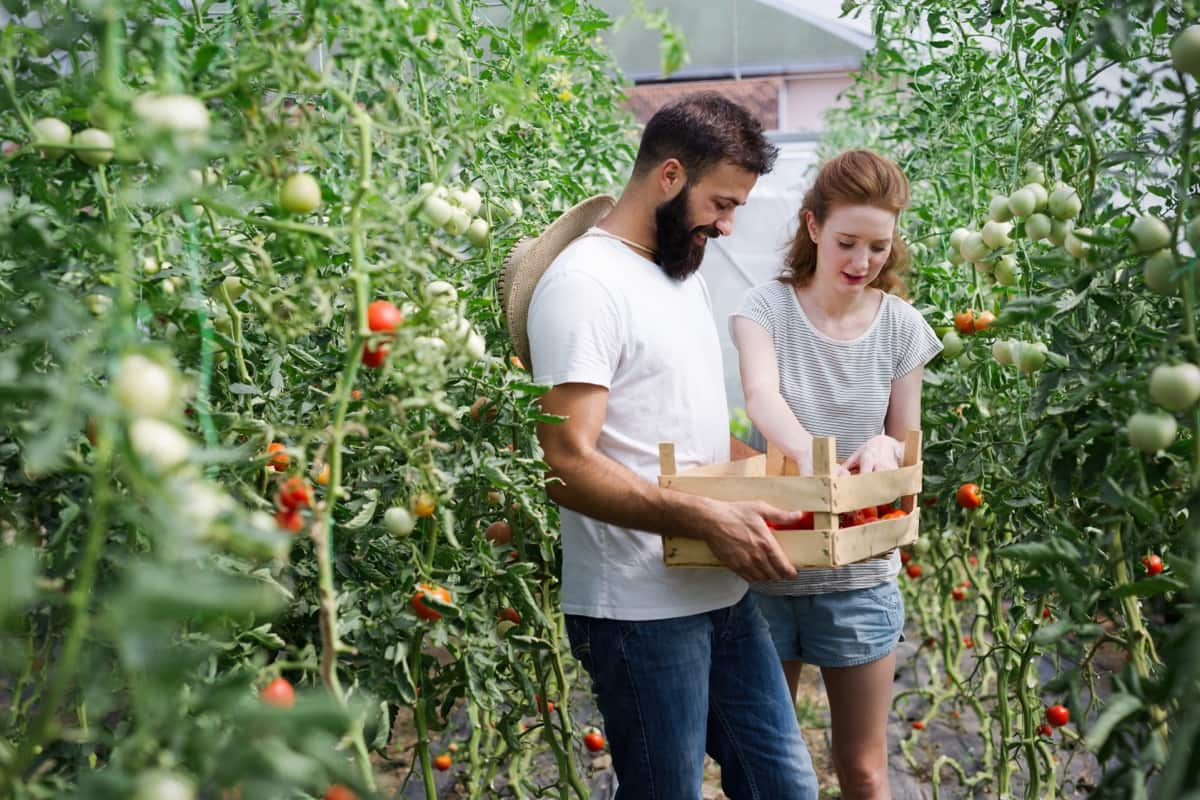
What happens if I don’t stake my Tomatoes?
Tomatoes need to be staked to help them grow tall and produce fruit. Without the support of a stake, a Tomato plant will typically grow only about 18-24 inches tall. If you don’t stake your Tomato plants, they may lean over and eventually touch each other, causing the branches to break and the plant to fall over. If this happens, remove the fallen Tomato plant and replace it with a new one that has been staked.
Conclusion
Staking your Tomato plants is an easy way to help keep them upright and off the ground, making it easier for you to manage their growth. By staking your Tomato plants, you can prevent them from reaching too high up into the air and becoming difficult to reach. You can stake them using wood or metal stakes, depending on the type of Tomato plant you are growing.
- Economical Aquaculture: A Guide to Low-Budget Fish Farming
- 15 Common Planting Errors That Can Doom Your Fruit Trees
- How to Make Houseplants Bushy: Effective Tips and Ideas
- Innovative Strategies for Boosting Coconut Pollination and Yield
- Pollination Strategies for Maximum Pumpkin Yield
- The Complete Guide to Chicken Fattening: Strategies for Maximum Growth
- Natural Solutions for Tulip Problems: 100% Effective Remedies for Leaf and Bulb-Related Issues
- Revolutionizing Citrus Preservation: Towards a Healthier, Greener Future
- Natural Solutions for Peony Leaf and Flower Problems: 100% Effective Remedies
- Maximizing Profits with Avocado Contract Farming in India: A Comprehensive Guide
- Natural Solutions for Hydrangea Problems: 100% Effective Remedies for Leaf and Flowers
- The Ultimate Guide to Choosing the Perfect Foliage Friend: Bringing Life Indoors
- From Sunlight to Sustainability: 15 Ways to Use Solar Technology in Agriculture
- The Ultimate Guide to Dong Tao Chicken: Exploring from History to Raising
- The Eco-Friendly Makeover: How to Convert Your Unused Swimming Pool into a Fish Pond
- Mastering the Art of Delaware Chicken Farming: Essentials for Healthy Backyard Flocks
- 20 Best Homemade Fertilizers for Money Plant: DIY Recipes and Application Methods
- How to Craft a Comprehensive Free-Range Chicken Farming Business Plan
- Brighten Your Flock: Raising Easter Egger Chickens for Beauty and Bounty
- How to Optimize Your Poultry Egg Farm Business Plan with These Strategies
- Subsidy for Spirulina Cultivation: How Indian Government Schemes Encouraging Spirulina Farmers
- Ultimate Guide to Raising Dominique Chickens: Breeding, Feeding, Egg-Production, and Care
- Mastering the Art of Raising Jersey Giant Chickens: Care, Feeding, and More
- Ultimate Guide to Raising Legbar Chickens: Breeding, Farming Practices, Diet, Egg-Production
- How to Raise Welsummer Chickens: A Comprehensive Guide for Beginners
- How to Protect Indoor Plants in Winter: A Comprehensive Guide
- Ultimate Guide to Grow Bag Gardening: Tips, Tricks, and Planting Ideas for Urban Gardeners
- Guide to Lotus Cultivation: How to Propagate, Plant, Grow, Care, Cost, and Profit
- Agriculture Drone Subsidy Scheme: Government Kisan Subsidy, License, and How to Apply Online
- Ultimate Guide to Raising Araucana Chickens: Breed Profile, Farming Economics, Diet, and Care
- Bringing Hydroponics to Classroom: Importance, Benefits of Learning for School Students
- Ultimate Guide to Raising Polish Chickens: Breed Profile, Farming Economics, Diet, and Care
- Ultimate Guide to Raising Australorp Chickens: Profile, Farming Economics, Egg Production, Diet, and Care
- Silkie Chicken Farming: Raising Practices, Varieties, Egg Production, Diet, and Care
- Sussex Chicken Farming: Raising Practices, Varieties, Egg Production, Diet and Care
- Homemade Feed Formulations for Livestock: Discover Cost-effective Starter to Finisher Feed Recipes